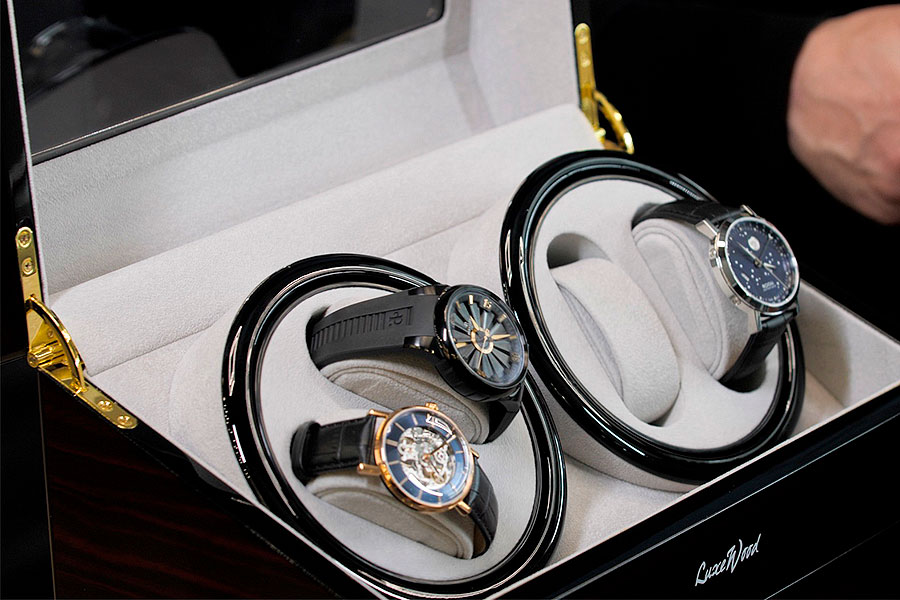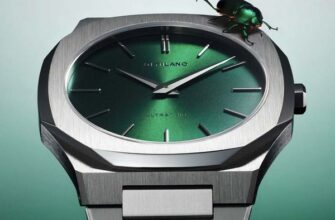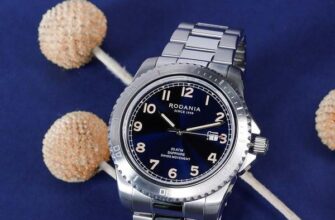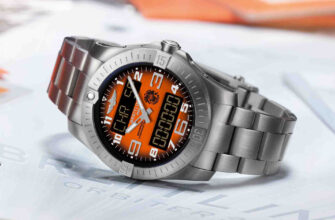It's no secret that literally everyone collects today - from supercars to matchboxes. But we're going to talk about such a worthy collectible as a wristwatch. And let's start with the basics: any collection requires storage space. With supercars in this sense, it is somewhat difficult, with matchboxes is simpler, but what about watches?
Watch collectors know: it is important that the watch is not “dead”, but is running properly. Moreover, if the collection contains models with complex functions, such as calendars, moon phases, additional time zones, etc. If the clock is standing, then the pleasure of looking at it (and collectors love to admire their treasures), from the proud demonstration to other people - is not at all the same. And every time re-winding the watch, setting the time, date and everything else is a big hassle.
This is where two fundamental inventions come to the rescue. Before calling them, we note that they are useful not only for collectors, but also for ordinary people.
Self-winding
So, the first invention: the automatic winding of mechanical watches. It was invented and registered in 1777 by Abraham-Louis Perrelet. The bottom line is that the watch mechanism is supplemented with a unit, the main part of which is a freely oscillating weight, called a rotor. It must have a sufficient moment of inertia (weight x shoulder). Oscillations of the rotor, through the transmission, are transmitted to the mainspring, winding it up.
At the time of Perrelet, wristwatches did not yet exist, personal watches were pocket watches, mostly resting. Nevertheless, even then, the invention was relevant. With the emergence and distribution of wristwatches, it acquired special significance: after all, being on the wrist, the watch is almost always in motion - which means that the self-winding rotor also works almost constantly.
By the way, if the back cover of the watch is transparent - this is the case for most high-end models - then the rotor vibrations are clearly visible through it. And, for example, the Perrelet company practices the installation of two rotors, one of which is placed on the side of the dial.
It remains to add that modern designs exclude the so-called "rewinding", which is dangerous for the mainspring.
Casket
The second invention: a box for an automatic winding. Indeed, it is rare that a person wears the same watch all the time. And even if he does, he sometimes sleeps ... In general, a self-winding box, aka watchwinder, is a very useful thing. And easy to use. You open it, put the watch in the slot intended for it, close it, provide it with electricity (plug-socket or batteries), press the button ... The electric motor starts to work. The clock in the box starts rotating. And, accordingly, they are winding - if, of course, they are self-winding.
Varieties
Firstly, as already mentioned, the boxes can be powered from the electrical network, or from ordinary batteries. Many models have both options. Sometimes for a timemover (another name for such devices) in its basic configuration, only power is provided from the mains, but often it is possible to purchase an adapter that allows it to work on batteries.
Secondly, caskets are designed for a different number of winding watches, from one piece to a whole collection - for example, up to 20 pieces. When creating such multi-boxes, manufacturers take into account that watches should be placed in them without interfering with each other, even if these are models of considerable dimensions.
Thirdly, watch winder designs offer certain sets of winding modes. After all, there is no need to rotate the clock continuously, to put it mildly. Work-rest cycles are much more reasonable. And the owner is given the opportunity to choose the parameters of the cycle: for example, 10 minutes of rotation and 50 minutes of rest, or in other proportions. Usually, the modes are indicated by the number of revolutions per day (for example, 650 - 1300 - 1950), which correspond to the numbers near the control toggle switch.
Sometimes it is also possible to select the direction of rotation: clockwise, counterclockwise, mixed cycle. In multi-boxes, as a rule, there are several electric motors with a separate setting for each.
Beautiful thing
And finally: appearance. A watch winder can become a real interior decoration! These items are made, including from rare wood species, covered with piano lacquer, decorated with inlays, sheathed with leather, and inside with velvet or leather of various colors, etc. It is worth noting: the box is still especially good when it works!
The processes taking place inside a beautiful thing and observed through a transparent cover are simply mesmerizing. In some models, designed for several watches, drawers are also made for storing manually-wound watches.
Naturally, depending on the materials and design, the box can be an expensive pleasure. But it's worth it, and besides, the watches stored in the box are still more expensive - and, in principle, much! So the cost of a good watch winder is relatively small, and the benefits of it (and the pleasure) can hardly be overestimated.
As an illustration, we will give examples of boxes for automatic watch winding.
Luxewood Neu Feste LW066-51-5

Two electric motors, two pairs of sockets (a total of 4 watches, up to 47 mm in diameter). Works both from the mains and from batteries. The case is made of MDF, veneered with wenge wood, covered with piano lacquer, interior decoration - eco-leather. Dimensions: 32,8 x 18,5 x 23,5 cm. Rotation clockwise, counterclockwise, mixed mode, revolutions per day - from 2160 to 4320, setting separately for each motor. Transparent cover. Drawer for storage of six watches. Lockable with a key.
Prestige WW-1219-BL
The design bureau of the Prestige company is located in the USA, the production is in the PRC. The box is designed for one watch with a diameter of up to 80 mm. Works both from the mains and from batteries (two pieces of AA format). The body is made of wood, covered with glossy black varnish, the interior is made of eco-leather. Dimensions: 14,5 x 14,5 x 16 cm. Four operating modes (750, 1000, 1500 and 1800 revolutions per day).

Luxewood LW622-5

Country of origin - Germany. Two electric motors, two pairs of sockets (a total of 4 watches, up to 55 mm in diameter). Works from the network. The case is made of MDF, veneered with wenge wood, covered with piano lacquer, interior decoration - velvet. Dimensions: 32,8 x 18,5 x 23,5 cm. Rotation clockwise, counterclockwise, mixed mode, revolutions per day - 650, 1300, 1950, setting separately for each motor. Additional drawer for storing four watches.









